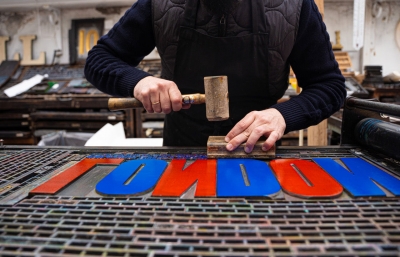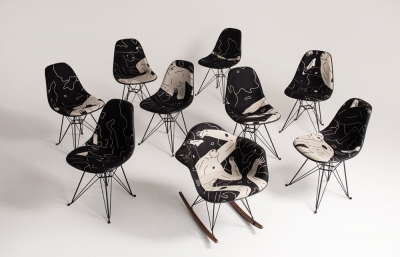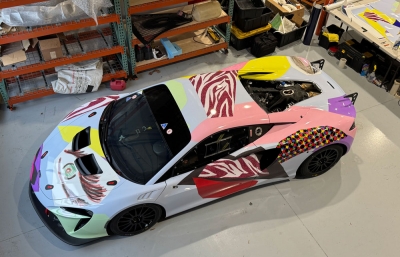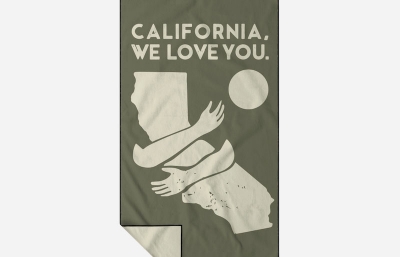In 2015, designers Jesse Reed and Hamish Smyth had a brilliant idea; as NASA imagery is public-domain, they created a Kickstarter campaign to publish the NASA Graphics Standards Manual as a hardcover book. Not only a totem of graphic design excellence, the book would also document a pivotal point in NASA’s history.
All book spread photography by Brian Kelley
The community agreed; not only did they want the reissue published, but over 7,000 backers contributed to the the project. As the 220-page NASA Graphics Standards Manual ships worldwide, we sit down with Reed and Smyth to talk about the genesis of the project and the special relationship they forged with NASA’s graphics.
Evan Pricco: The first thing I wondered when seeing the book was how NASA presented the manual when it was in circulation.
Hamish Smyth: The original manual was contained in a binder. Each page was 8.5" x 11", with a series of holes down the left edge. The binder was obviously a little larger, with a silver ring mechanism and what I can best describe as a faux leather sort of cover, like school binders. The logo and title are screen-printed on the cover and spine.
The reason the manual was in a binder, and this applied to most manuals of the era, was updatability. The original manual was a lot leaner than the version we see today. Danne & Blackburn worked for many years creating new sections, which would be printed and distributed to NASA offices to be inserted in the binder. Over the years, the manual grew.
We chose to present our version in a hardbound book for a few reasons. First, we wanted to preserve the color of the original. We scanned the entire page, and cropped it on a white background. Each image is then set on a page with a 0.25" border, allowing you to see the whole edge of the original page. If we wanted full-bleed images, we would have to place 0.25" of the page images into the bleed, which is at risk of being sliced off during book production. We did not want to lose any of the original.
Second, we wanted to make a book about the manual, not a reproduction of the original binder. What I mean by this is we wanted to include other information about the manual. The book starts with a foreword from the manual’s original co-designer, Richard Danne, followed by a fascinating, 6,000-word essay from New York Magazine’s Christopher Bonanos on the history of NASA’s logos, and the rise and fall of the “worm” font. Then you see all of the original pages of the manual. After that, we show the original 35mm slides that Danne & Blackburn presented to NASA administrators in 1974, accompanied by an explanation from Mr. Danne. And last of all, we scanned and reproduced a publication called The Manager's Guide, a document that was distributed to NASA coordinators some years after the manual launch, and detailed how the new identity was being used at NASA, and how their departments could also use the manual.
Lastly, and perhaps this is most important, creating a facsimile binder would be cost prohibitive. We looked into it, and the cost per unit was so high we knew many people would be unable to afford such a book. We want to share this piece of design history as widely as possible, and I think the format we decided on gives the reader a huge amount of information that would not have been present in a straight facsimile.
Why did NASA need something like the manual Danne & Blackburn were asked to design in the mid-’70s?
Jessie Reed: Richard (Danne) has given us really great insight into this question. NASA was a large agency with many bureaus that worked toward the same greater goals. In terms of visual communication, each center created their own materials that were not necessarily consistent with each other and the greater mission. It’s not that NASA needed a stronger marketing voice, but they lacked the authority that a major federal agency should have. Richard often points out that the United States was far behind in recognizing the role of design in society, especially when compared to Europe and elsewhere around the world.
In 1972, the National Endowment for the Arts established the Federal Graphics Improvement Program that would identify agencies in need of a stronger visual identity, which was nearly all of them, incidentally, and rethink their graphics program one at a time. NASA was chosen to be the benchmark, and in 1974, a request for proposals was issued to firms around the country. Even though Danne & Blackburn were relatively small, their basic principles, clearly in development, brought a voice of clarity, confidence, and conviction to the way NASA would be regarded. This wasn’t only important for internal communication, but I think gave our nation a true sense of pride through its visual strength.
All of this information in the guide is public domain, right?
HS: Yes, the NASA manual is in the public domain, as it was a publicly funded program. We learned about the manual’s existence early in our careers, but it was not until our first book project, the 1970 NYCTA Graphics Standards Manual, that we considered approaching Mr. Danne and doing the same for NASA. The NASA manual is one of the holy grails of design. It almost seemed out of reach, but we worked up the courage to contact Mr. Danne, and he has become a close friend and collaborator since.
The fantastic response received when you brought the project to Kickstarter made it quite clear that the community wanted this book to be available. What did you learn in the process?
JR: We’ve learned so much from both of our campaigns, luckily with nothing too tragic. Crowdfunding can be very different depending on the product, but it’s proven to be a very interesting model for book publishing, and there are some really great aspects to the entire process. First, it really is an inclusive relationship that you have with someone buying your book. They didn’t just go to a store and pull something from the shelf, they were there when an idea existed and now they’re holding that idea in their hands. On our end, it cuts out most of the risk that a traditional publisher would never touch. If you’ve done your homework and set realistic budgetary goals, there is nothing to lose, generally speaking, if the project fails. But if you reach your goal, everything is accounted for and the guesswork is eliminated.
What sort of interesting things did you learn when researching and making this project? Certain things that you could apply to your own jobs?
HS: One of the most interesting things I learned from Richard was how the rollout was handled poorly and how that could have derailed the entire program. When NASA approved the work, instead of issuing a company-wide memorandum explaining the change, they simply mailed each center director new stationery. People don’t like change, and as you might imagine, this sort of change ruffled a few feathers. NASA realized the bungle, and Richard and Brice of Danne & Blackburn spend the next few months traveling all over the country to meet with center directors and explain the new system.
We still see design systems being introduced poorly today, like the infamous Gap logo redesign a few years ago, or the recent controversy over the Tokyo 2020 Olympic Games logo. Launching a design system today is perhaps more difficult with the internet and ensuing instant feedback and discussion, but the fundamental lesson is that you need buy-in from all parties in an organization, and a clear plan to execute. Thankfully, Mr. Danne and Mr. Blackburn convinced all of those directors to go with their plan, and we have the manual to prove it.
----
Originally published in the July, 2016 issue of Juxtapoz Magazine, on newsstands worldwide and in our webstore.



















